InTramCities with Gordon Stewart : Special Report
West Germany in the 1970s : Additional photos by Ian Stewart
Gordon Stewart and his
father Ian visited West German tramways on several occasions in the 1970s. It was a time when towns and cities, large and small
were debating vigorously about what to do with their tramways.
Gradually close them
down, as some places were, modernise and expand, or as many of
the major cities tried, dig as many tunnels as possible and run their
trams underground. For most, this proved to be
far too ambitious and cheaper alternatives were sought. Many were left
with compromise solutions and several cities created problems of their
own making due to the differing levels of compatibility between their
new developments and their existing tramway infrastructure. Nobody was
quite sure what would be the outcome. It seemed that tramway
photography would largely be a matter of catching views before
most were finally closed down. As it turned out, the 1980s saw
the development of the low-floor tram which would bring a great
improvement in the physical accessibility of trams. The low floor tram
probably
saved the street tramway and changed the public's perception of
them. This special report by Gordon Stewart showcases some of the
photos taken in the 1970s and puts them in the context of the
developments taking place at the time.
Featuring
: Heidelberg - Mannheim - Ludwigshafen / Aachen / Kiel / Hamburg /
Stuttgart / Frankfurt (Main) / Hannover / Braunschweig / Karlsruhe / Dortmund / Bochum
- Gelsenkirchen / Essen / Herten - Recklinghausen / Herne / Mulheim
(Ruhr) / Duisburg / Dusseldorf / Krefeld / Wuppertal / Mainz /
Darmstadt / Wurzburg / Ulm / Augsburg / Freiburg
HEIDELBERG, MANNHEIM and LUDWIGSHAFEN

Heidelberg
(above) was one such city where the debate about what to do about the tramway raged. Complete closure was
not seen as an immediate prospect even if a longer-term aspiration, but
three branches had already been closed in the early part of the 1970s
alone. Fourteen more articulated trams of a well-tested Duwag design
were delivered in 1973, with tram 230 the first of the batch. It was
only one year old in the photo above, taken in 1974, when it was seen
approaching Bismarckplatz on Hauptstrasse. The narrow street runs right
through the historic centre of the city and trams terminated at
Karlstor, close to the terminus of the funicular to the Konigstuhl
which overlooks the city. Although private cars can be seen in the
photo, it was the trams which were the first to be removed, taking
place from June 4th, 1976 and the street eventually became a pedestrian
zone.

In 1974, Heidelberg
still operated a number of smaller two-axle cars. The delivery of
this "Verbandstyp" design which built on a wartime utility design
came in 1955 and 1956 and although less than twenty years old they were
very much outdated by 1974. The obsolete tram (75, above)
contrasts with the modern reserved track alignment along the
Kurfurstenanlage near Hauptbahnhof which suggested that at least
some of Heidelberg's network was suitable for the requirments of the
rapidly modernising world.

Bismarckplatz remained a busy tram station in Heidelberg's
city centre although it was now a reasonably long walk for people to
reach the heart of the old city. Replacement buses did not run along
Hauptstrasse and only skirted the southern side of the pedestrianised
area. Tram 238 was still only four years old when seen on July 27th,
1977, but it was based on a visual design from the late 1950s at a time
when several other cities were ordering something much more modern
looking.

One of the factors favouring the retention of a tram service through Heidelberg
was the OEG (Oberrheinishe Eisenbahn Gesellschaft) service which linked
Heidelberg to the neighbouring larger city of Mannheim in a loop line
which also connected the town of Weinheim. Parts of the OEG line were
"inter-urban" in nature with sections of reserved track which were seen
as not impeding road traffic. Whether the OEG service was justified
financially was another matter, but both tramways survived the doubts
and entered the days of tramways' renaissance with renewed confidence.
Trams of both the local Heidelberger Strassenbahnen (HSB) and OEG are
seen above in the increasingly "popular" all-over advertising livery
which operators welcomed as an additional source of income. The OEG's
tram 83 was one of a number of eight-axle double articulated sets
purchased in the 1960s, this one being from Duwag in 1966 and
presenting a rather larger appearance than Heidelberg's own trams. The
tram in red represented the latest in new trams for the Heidelberg
system, one of four eight-axlers for the Leimen route. This photo was taken
on July 27th, 1977 when the Heidelberg tram was completing its second
year of operation.

The OEG network is run jointly by the authorities of Mannheim,
Heidelberg and Weinheim and is one of the survivors of the numerous
light railways which were once common throughout Germany. Tram 103 dates from
1973, so was relatively new when this photo was taken in Seckenheim
on July 27th, 1976. The reserved alignment indicates that
the OEG's heritage is light railway rather than tramway and the route taken
into Mannheim and its terminus at Kurpfalzbrucke from Heidelberg via
Seckenheim had no shared operation with Mannheim's own trams.

Seckenheim
Bahnhof on the OEG route from Mannheim to Heidelberg on July 27th, 1976
with one articulated tram and a three car "Grossraumwagen" set from a
generation of trams delivered throughout the 1950s until as late as
1963.

Mannheim
itself operates a large street-based tramway and with the exception of
a very short section of subway on Luisenring, has not opted for
underground running. Duwag tram 323 was sixteen years old when seen
here on Moltkestrasse on July 27th, 1976

Moltkestrasse in Mannheim
was served by numerous lines which could lead to a build of of trams.
Duwag had become the tram supplier of choice when Mannheim re-equipped
in the late 1950s and 1960s. Tram 453 was one of twenty delivered in
1970-71. It retained the traditional Duwag style but incorporated the latest in comfort and technology and this became
generally known as the Mannheim-type in Duwag's catalogue.

448 was one of a batch delivered to Mannheim in 1967 and is seen in front of the city's Hauptbahnhof

A Ludwigshafen tram (121) in Mannheim
at Tattersall. Mannheim and Ludwigshafen are positioned directly across
the River Rhine from each other and are linked by two bridges with tram
lines crossing not only the river, the city boundaries but also a state
boundary with services jointly operated by the two undertakings.

Although Mannheim is considerably the larger of the two and possessing a much larger tram network, Ludwigshafen
opted to construct tunnels for its trams. It was an optimistic move and
one which was to backfire . Tram 148 is seen on surface tracks
on July 27th, 1976

Running through Ludwigshafen
is the Rhein-Haardt-Bahn (RHB), a line jointly owned by the Mannheim
and Ludwigshafen undertakings, which links Mannheim with Bad Durkheim.
Although interurban in character after leaving the Ludwigshafen urban
network at Oggersheim where local services terminate, it runs as a
street tramway otherwise. Notable is the length of the tram. 1022
is a five sectioned articulated car with twelve axles, four examples of
which were received from Duwag in 1967
AACHEN

The city of Aachen
was coming to the end of its programme of tramway closures when
this photo was taken in the summer of 1974. A large network of
interurban lines linking surrounding
coal-mining communities and stretching over the nearby Dutch and
Belgian borders had disappeared and the remaining city-based lines
followed in the early 1970s. The final cross-city
line closed at the end of September 1974. The city had maintained some
degree of modernity in its fleet by buying in second
hand trams, including from nearby Monchengladbach (above) where tram
operations ended in March 1969 and Oberhausen (below) whose trams ran
for the
last time in October 1968. Aachen was following the national trend -
and a trend
which was expected to continue

Aachen
: One of four Westwaggon-built trams brought in from Oberhausen.
These were still only thirteen years old when this photo was taken in
1974
KIEL

Another tramway which did not survive was in the northern port town of Kiel.
By the mid 1970s (this photo is thought to be from 1975) the tramway
consisted of one remaining line only and it was to close in May 1985.
Tram 263 was one of fifteen six-axlers delivered by Duwag in 1960 and
1961. The trailer is a so-called Aufbauwagen, built in 1949 on trucks
from an earlier tram destroyed during the war and came from the city of
Lubeck in 1960 following the closure of the nearby system in November
of the previous year
HAMBURG

Hamburg
: It was not only smaller and medium-sized cities which were debating
what to do about their tramways. The three largest cities in West
Germany, Munich, Cologne and Hamburg were also grappling with the same
issues, but for different reasons. There was the usual thought about
freeing up road space in the hope of allowing cars to circulate more
freely, but also the ambition to equip their cities with something much
grander - an underground railway network. The outcomes were all
different. Cologne retained its trams and built a large network of
tunnels to run them through the city centre. Munich embarked on an
ambitious plan to build its underground (U-Bahn) which was to become
reality and complement a large regional railway (S-Bahn) network with its own underground tunnel in the city centre. Hamburg
had a well-advanced U-Bahn and a good local railway network which they
concentrated on expanding and developing. Munich started to cut back
its tramway network in the ultimate belief that it would not be
required once their U-Bahn plans had been realised, but this was
to be a long and phased process. It was long enough for times to change and
for the tramway not just to be to be saved, but expanded as a vital surface-aligned
complement to the the heavier modes. Hamburg's plan was much more
severe. Trams would be removed in their entirety - and quickly - with
the motor bus being the direct replacement. By October 1st, 1978,
Hamburg trams were no more. Hamburg had not bought trams since the
1950s and not even had articulated cars. 3553, seen above in 1975, had
been in service since 1951.
STUTTGART

Germany
has many cities with populations in the 500,000 bracket. They are not
mega-cities in world terms in that respect, but in the 1970s, there was
a confident expectation of future growth. What transport
system would they need and what could they afford ? History had
left them with large street tramway systems, but systems needing major
investment and systems which seemed to many to be inappropriate for future needs. As a
result, the "Stadtbahn" concept was formulated : a mixture of tram and
underground railway which could be built in stages as finances
permitted but integrated to the extent that trams could, at least in
the immediate future, run through the tunnels imitating "proper"
underground railways in the city centre. Outside the centres, they
would run as traditional tramways, but be upgraded on to tracks
segregated from traffic and ultimately, it was hoped, be able to to be
converted to the wished-for U-Bahn standard. Stuttgart
was the city that followed the concept most closely and since the 1970s
has been able achieve perhaps the best results. U-Bahn systems would,
amongst other things, be based on standard-gauge tracks. Stuttgart,
along with many other cities, possessed a tramway with metre-gauge
tracks. This was not a problem to the extent that a suitable time in
the future, lines could be converted and this happened in Stuttgart.
For many years, three rails could be seen so
that standard-guage "Stadtbahn" cars and metre-gauge trams could run
along the same track. Stuttgart's tunnels were built in bite-sized
chunks and outer alignments upgraded according to a long-term plan. In
the photo above, taken in July 1977, a metre-gauge tram has just ascended the ramp in the
middle of Konigstrasse, the city's prime commercial and retail street.
A tram tunnel had been opened under the north-eastern section of the
street and in front of the main railway station (in the background)
where a major interchange station was being constructed. The tram is
approaching Schlossplatz, whilst tunneling work continues underneath
and once ready, the ramp would be removed and trams removed from
the surface in this part of the city.

Stuttgart
: Trams still run on the surface of Konigstrasse at Schlossplatz
in July 1977 - but not for long as the tunnel underneath the square is
close to completion

Stuttgart
: Trams still run along the south-western part of Konigstrasse in July
1977. There is no tram tunnel under this part of the street, but the
link with Hauptbahnhof would be retained via a new tunnel for regional
heavy railways and the trams removed. Trams turn left or
right at Rotebuhlplatz.

Stuttgart :
Those trams turning left out of Konigstrasse immediately encountered a
ramp leading to the tunnel network, from where a tram emerges in the
photo above. This ramp was also temporary, allowing trams to use the
tunnels as they became ready in stages. It would be some time later that conversion to standard-gauge took place.

Stuttgart : At Liederhalle in July 1977 tunnels await use by trams but the surface alignment above the excavations remain in service

Stuttgart :
An example of an upgraded surface alignent at Mercedesstrasse on the
line to the northern suburban centre of Bad Cannstatt where the tracks
cross the River Neckar. Sleepers were installed in such a way as to
accept rails of 1435 mm spacing (standard gauge) when required

Stuttgart :
Wilhelmsplatz is the central transport interchange in Bad Cannstatt and
on 26th July 1977 presents a traditional tramway scene with no hint of
the changes which will be evident once the system is converted to a
standard-guage "Stadtbahn"
FRANKFURT-am-MAIN

Aufbauwagen 478 pulls two trailers in a soon to disappear view in central Frankfurt in 1974

A two-axle tram pulls a three-car set past St Katherine's church at Hauptwache

Aufbauwagen 462 heads along the "Altstadt Strecke" in 1974

Driver
training car 1 was built by Crede in 1954 and converted for its later
use in 1974. It is seen in bound, turning out of Vogelweidstrasse into
Paul-Ehrlich-Strasse

Railgrinder 2021 at Opernplatz

Busy scene at Hauptwache
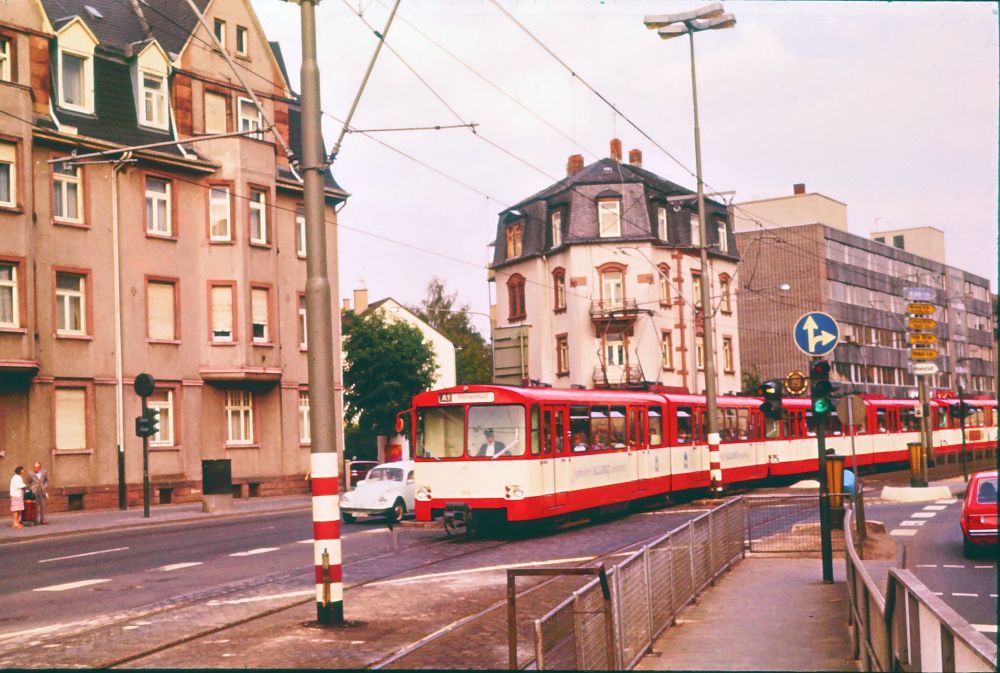
Frankfurt-am-Main
was another half-million-sized city with lofty ambitions commensurate
with its status as Germany's financial centre. Its policy was to attain
a "track-free city centre" by moving its trams into a network of
tunnels. Frankfurt had the benefit of a standard-gauge tramway system
but its plans brought other problems which were to land the city with a
set of hybrid solutions which were to prove slightly unsatisfactory for
many years. Frankfurt's ideal solution would have been to have a
genuine underground railway, but it to had to compromise by putting its
trams underground in stages. However, it wanted to have "trams" which
were much closer to U-Bahn sets, wider than convential trams,
running in multiple coupled units and operating much like an
"underground" from the outset. The photo above, taken at the Weisser
Stein station on the
Eschersheimer Landstrasse in northern Frankfurt on August 2nd, 1976,
shows the "A" line, the first
upgraded line to be put into operation. The vehicles, built by Duwag,
were designated as "U2" and were clearly meant to be at least some way
towards being "underground railway" stock. yet were running on tram
lines with the existing station platforms built accordingly to a low
height. The platforms in the tunnel sections were therefore built to
match. This hardly represented the ideal U-Bahn when passengers had to
alight using steps as had been normal practice for trams. One
concession to upgrading the line was to fence off the central
reservation and reduce the number of open road crossings - allowing
much faster speeds, but also virtually cutting communities in half
.

Frankfurt :
The early years of the A line saw the U2 cars share services with
traditional trams as seen here at Weisser Stein in 1976. Trams did not
use all of the A-line tunnel. A temporary ramp at Taunustor allowed
tram-operated services to reach the surface and continue running in a
more traditional manner rather than terminate at Theaterplatz (now
Willy-Brandt-Platz). The extension of the A line under the River
Main to a new terminus at Sudbahnhof in 1984 was the cue for further
closures of survace tracks in the city centre. It was many years before
the A line
could be
converted to high-platform operation and by that time the U2 cars had
been
replaced by a newer generation of stock.

Frankfurt
was at the forefront of modernising its tramway fleet in
conjunction with the Dusseldorf-based manufacturer Duwag. The 1970s
also saw the introduction of the "P" class cars, commencing in 1972,
which moved on from the classic Duwag tramcar design so familiar in
Frankfurt and a large number of other West German tramway systems.
Tramway routes were also built into developing areas such as Niederrad
(above, with P-type tram 664 in 1976 on tracks opend on June 1st, 1975) where a new "Office City" was
being established. Whilst presenting a modern appearance, platforms
were still low and the tram's floors were still high, requiring the use
of steps. For subsequent underground developments, particularly the "B"
line which, Franfkurt had a dilemma. Low platforms were ruled out for
the underground stations, but high platforms were not available on the
tram routes themselves and would not be available for many years - and
at great cost. The solution was to equip a number of P cars with
folding steps to allow them to use high platforms in the underground
stations. Frankfurt also had to decide which tram routes would
eventually become part of the "U"-designated Stadtbahn-style lines and
what was to become of the remaining tram lines. A further
complication was that the tunnels were built to be served eventually by
wider cars than the tramway-style P cars and for many years intering
solutions were used whereby certain platforms were fitted with
extensions to close the gap with the narrower cars or the cars using
the tunnels were fitted with extensions around the door areas to do the
same job. A number of interim solutions were in use for many
years.
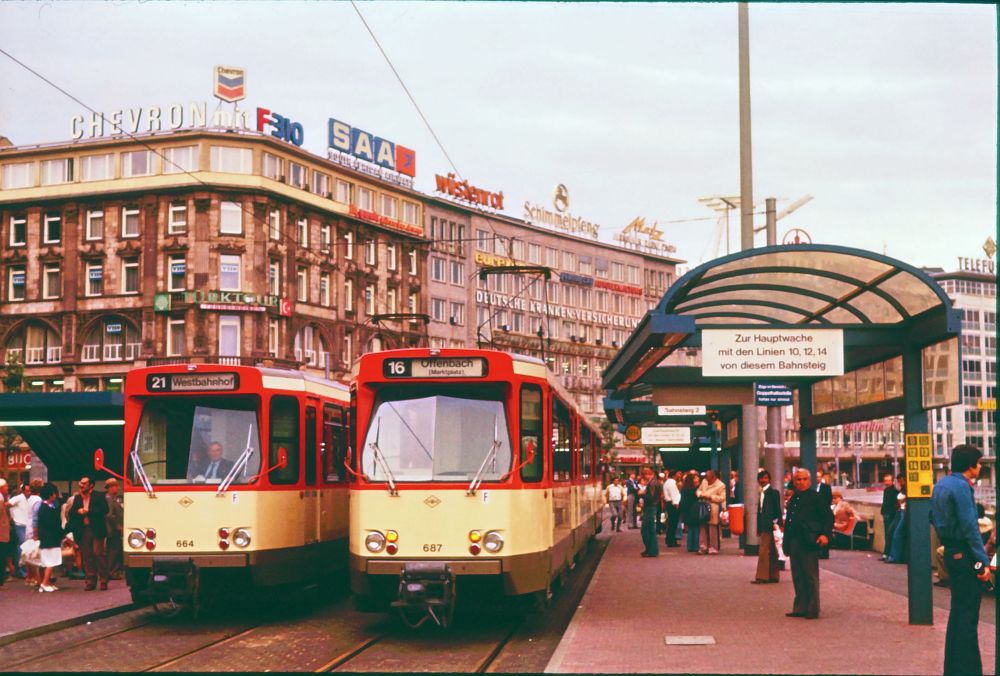
Modern P-type trams 664 and 687 are seen outside Frankfurt
Hauptbahnhof in a modernised tram station. Although Hauptbahnhof
was to be served by an underground line, it was expected that surface
lines would be seen for many years to come and passengers would still
be required to climb in and out of the vehicles rather than have the
benefit of level access. What was anticipated, however, was that the
surface link to and through the city centre via Munchener Strasse would
eventually disappear. It was not until the 1990s that the ambition for
a totally "track free city centre" was abandoned and the Aldstadt (Old
City) route won a last minute reprieve. This was not before the rest of
the city centre's tracks had been lost to further tunnel construction.
Nevertheless, in the 21st century it provides a valuable link to the
city centre and links the eastern and western parts of the surviving
tram network. The issue of stepping up to the trams from street level,
a major problem for street tramways in the 1970s, for passengers in
general and for disabled passengers in particular, wsas soon to find a
solution. Trams could be built with low floors, either in part or
eventually throughout their entire length due to design improvements
such as shifting electrical equipment from underfloor to the roof and
changing wheelset and bogie design. Unfortunately for Frankfurt. the
"low-floor revolution", which gathered pace in the 1980s, came slightly
too late as the city had already embarked on its massive tunneling
projects and had hard-wired a high-platform design for its upgraded
"U-Bahn" routes. Frankfurt was quick to buy low-floor trams when it
needed to re-equip its remaining traditional tram routes and this is
one reason why trams are now highly favoured as an attractive,
accessible and, in comparison to the U-Bahn, relatively inexpensive
solution.

Despite the constant stream of new stock, a number of two axle trams remained in Frankfurt
deep into the 1970s. 449 is one of the "Aufbauwagen" type, delivered in
the 1949-51 period, but constructed on older trucks recovered from
trams destroyed by bombing during World War II. They were
increasingly anachronistic in a city such as Frankfurt, the last being
withdrawn from service in 1978. Despite being only just over 25
years old when seen in 1976, the difference in pereived age between
these and, for example, the P cars at the same age is striking.

Despite all the frantic construction work and the big plans for the future, most of the Frankfurt
network was and would remain a traditional tramway. Eight-axle Duwag
tram 801, the first of a batch of thirty delivered in 1963, is seen in
a traditional setting near Vogelweidstrasse tram stop on the south side
of the River Main.

From late 1970, route closures and changes became increasingly prevalent in Frankfurt. On September 3rd, 1979, Two P8 cars wait at Hauptwache which had become a stub
terminus due to the closure of tracks in Zeil, the
prime shopping street of the city in May of the previous year - perhaps
the most significant change to the network at that time. The entrance
to the Underground (U)
and S-Bahn (S) stations below can be seen by the signage behind trams 707 and 714

The
closure of Zeil to trams would have had enormous consequences for the
operability of the network had services not been diverted to tracks
reopened on an alignement betweenn Goetheplatz and Schafergasse
via Schillerstrasse (tram 643, above) and Stephanstrasse slightly to the north of
Zeil. September 3rd, 1979

Frankfurt, 699 at Goetheplatz on September 3rd, 1979. The tracks in the foreground are disused.

Interchange
station at Ginnheim with P8 tram 742 approaching platform 1 with an
inbound service. To the right, the larger profile cars on the A line
also wait with an inbound service, but one which runs outwards via
Nordweststadt before turning south and reaching the city along (and
then under) the Eschersheimer Landstrasse. September 3rd, 1979
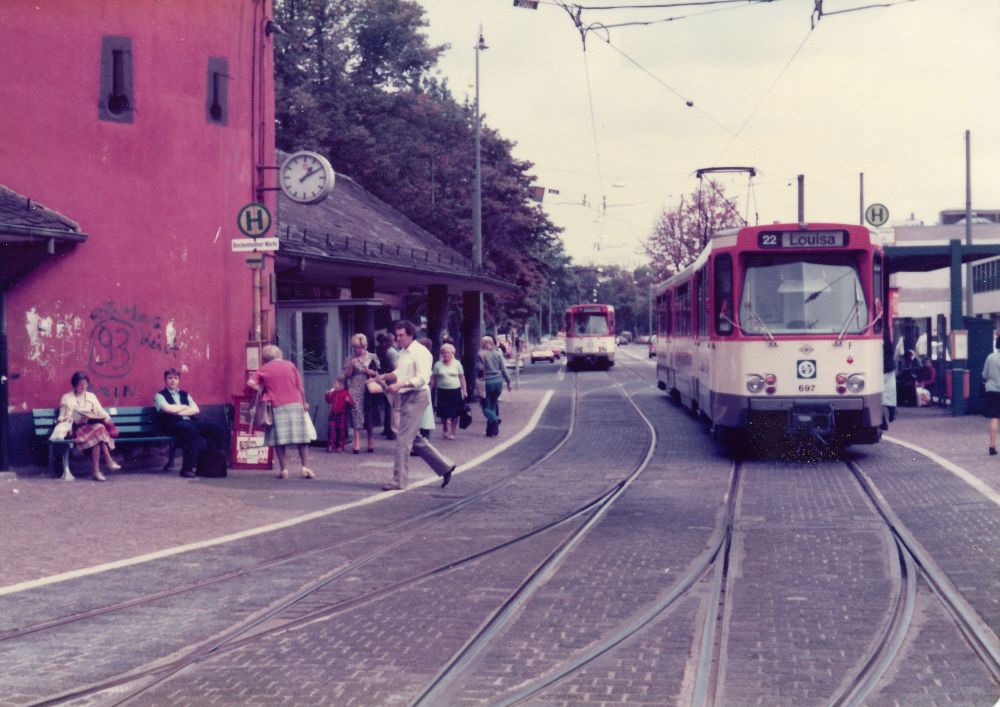
View
towards the city centre along Bockenheimer Landstrasse at Bockenheimer
Warte - an alignment which was to be replaced by an underground line in
1986.P8 trams 700 and 697 on September 3rd, 1979

Frankfurt - Tram 691 at Festhalle - Messegelande in on September 3rd, 1979. On the right, a tram is on Friedrich-Ebert-Anlage on route 18

Frankfurt - Hauptbahnhof in 1979

P8
tram 702 leaving Theaterplatz (now Willy-Brandt-Platz) on Neue Mainzer
Strasse towards the Untermainbrucke. The A tunnel (lines U1, U2
and U3) was extended to Sudbahnhof from Theaterplatz on September 29th,
1984 with the associated closure of the above line from Theaterplatz to
Schweizerallee/Gartenstrasse.

Theaterplatz (now Willy-Brandt-Platz), viewed towards the city centre from Munchener Strasse on September 2nd, 1979

Stresemannallee/Gartenstrasse - view towards the city centre.

Stresemannallee/Gartenstrasse - view outwards

Heinrich-Hoffman-Strasse

701 at Neu-Isenburg

Neu-Isenburg

Louisa on 3rd September, 1979

The A line in the central reservation of Eschersheimer Landstrasse at Fritz-Tarnow-Strasse, looking northwards, in 1979

The former "A" tunnel in 1979 with routes now designated U1, U2 and U3
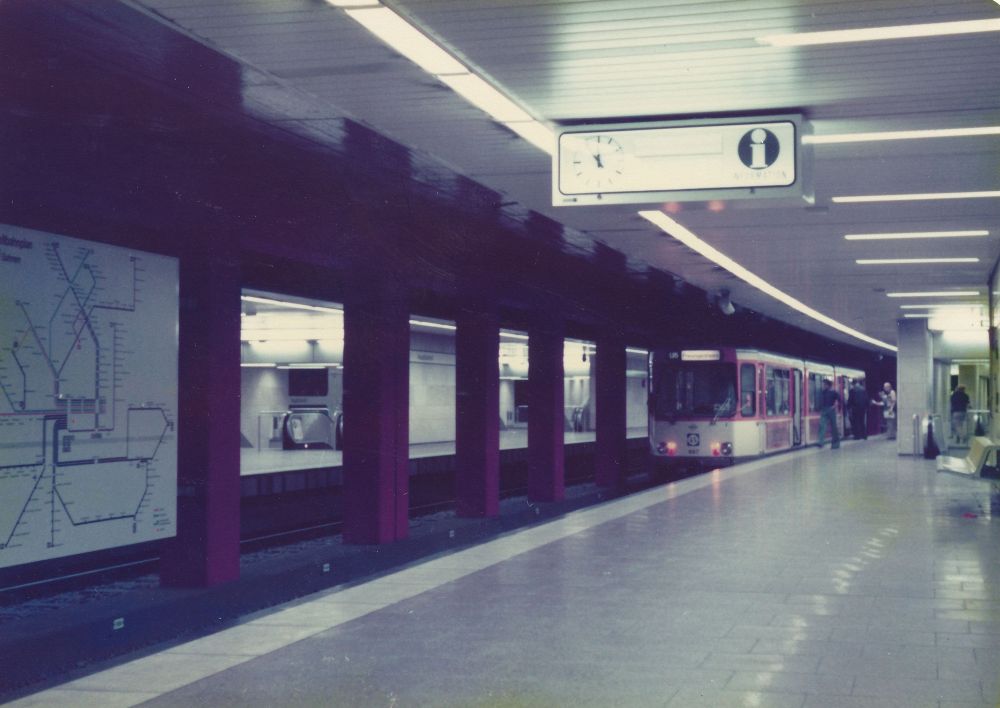
If
the A line had been a compromise solution with low platforms, the
so-called B line was also - but in a different way. The tunnel, opened
on May 26th, 1974 between Friedberger and Theaterplatz was designed for
use by genuine "U-Bahn" cars with level-floor access from high
platforms. The vehicles were not available and the only line feeding
the tunnel, at least initially, was the surface tram route from
Preungesheim, to where the line had been extended from Giessener
Strasse in 1977. There needed to be a solution which allowed the
2.35m-wide P8 trams use tunnels designed for use by 2.65m-wide U-Bahn
cars. A number of P8 cars were fitted with folding steps to allow
them to call at the new stations as well as traditional tram stops
(designated Pt) and a temporary strip was fitted along the platform
edges to bridge the gap between tram and platform. This continued until
1980 when the tunnels were extended to allow the introduction of a
genuine U-Bahn service to Bornheim (Seckbacher Landstrasse). At the
city end, the tunnel had been extended to Hauptbahnhof on 28th May, 1978 and seen above on September 2nd, 1979. With the tunnel
passing under the old city centre and served by a new station at Romer,
it was planned that the surface tram line through the city centre would
become redundant. The proposed closure of the "Altstadtstrecke" would
become a cause-celebre for the Frankfurt public and was
ultimately saved once a new pro-tram policy was followed by
the city authorities. That was, however, still some way in the
future. The Preungesheim route was cut back to terminate at an
underground stub at Konstablerwache and would remain so until it was
upgraded to allow through working.

The Frankfurt
S-Bahn network is connected by a tunnel underneath the city centre. The
first stage of this was the extension from Hauptbahnhof to Hauptwache,
opened in 1978 and seen in 1979
HANNOVER
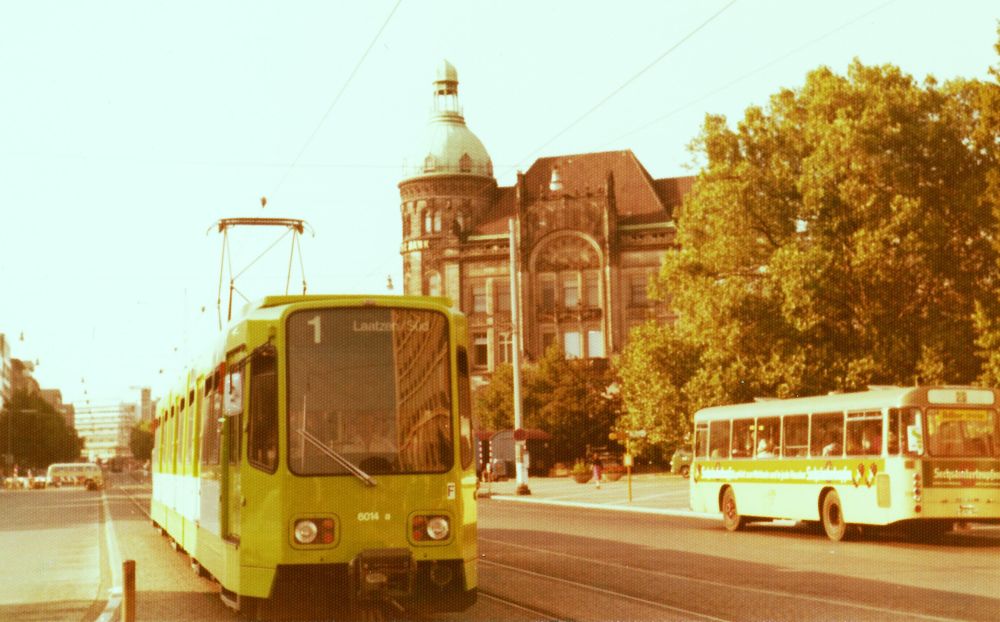
In
August 1975 Hannover was preparing for the opening of the first section
of tunnel of what was to quickly become a substantial subterranean
network in the city centre and the first of the newly-delivered
6000-series Stadtbahn light rail vehicles from Duewag were now in
operation. 6014 is seen approaching Aegidientorplatz on Georgstrasse.

August 1975 : outbound on Georgstrasse at Aegidientorplatz

Hannover enthusiastically
embraced expansion, but as a major city, it wanted an appropriate
transport system. Four underground axes under the city centre were
planned and three created in rapid time. As a "proper" modern system
required high platforms to achieve level access in the absence of
suitable low-floor vehicles, Hannover was left with an expensive
programme of converting its tram stops whilst using cars with folding
steps as an interim measure. One of the axis (designated the D - Line)
was not built and one tram line was left to penetrate the city centre
above ground. Remarkably, in 1977, there were still some cars in
service which were approaching 50 years old. 209 is one of the
reamining cars from abatch of firty two axle trams received from the
HAWA factory between 1928 and 1930. A "Grossraum" tram and trailer set
is also in view

In the 1950s, Hannover
turned to the Duwag factory at Dusseldorf for its new trams. Duwag were
establishing themselves to become what would be the dominant supplier
in West Germany for many years with their popular "Grossraumwagen"
design. This large-capacity car was a significant improvement on
earlier vehicles, especially Hannover's ubiquitous HAWA cars, but the
tram and trailer set-up was to be eclipsed by a six-axle articulated
design by the end of the decade
BRAUNSCHWEIG

Braunschweig's
tram network has schrunk to the bare bones of a once extensive system
by 1969 with a length of 7.5 miles (12 km). The main tram thoroughfare
was (and remains) Bohlweg, viewed southwards at Georg-Eckert-Strasse in
1975. The tracks branching to the left are for the new line in
Georg-Eckert-Strasse establishing a direct link to the Friedhof route.
This was one of a number of developments in the turnaround of the
system's fortunes after 1970 with routes to the north, west and south
added and the east-side route to Glesmarode extended to Volksmarode.

Above : Georg-Eckert-Strasse at the junction with Bohlweg in 1975 with a tram on the recently opened link.

Bohlweg / Damm looking northwards at Georg-Eckert-Strasse
KARLSRUHE

The tram network in Karlsruhe
appeared secure in the 1970s but exactly what the future would look
like was unclear. This view of Europaplatz on July 26th, 1977 gives a
hint. The yellow tram with red flashings is a Karlsruhe city tram which
is about to turn into the busy tram and pedestrian precinct of
Kaiserstrasse. The green and yellow tram, clearly of Duwag design, is
run by the Albtal Verkehrsgesellschaft (AVG) whose services linked the
city to Bad Herrenalp and Langsteinbach. The AVG, which was
converted from a metre-gauge interurban light railway to standard gauge
in the 1958-61 period, is majority owned by the city of Karlsruhe and
runs on city metals to reach Kaiserstrasse and Europaplatz from its own
"Bahnhof" adjacent to Karlsruhe's Hauptbahnhof. This provided the
template for a major expansion of light rail in the Karlsruhe region
with several "heavy" railways converted to operation by tram-like cars
to allow passengers to reach the heart of the city rather than have to
change to urban trams at Hauptbahnhof which is located at some distance
away. There was little interest in expensive tunnels ..... until the
new developments, which became known worldwide as the "Karlsruhe
Model", became so successful that tracks in the city centre became so
busy that a change had to be made. That was for the future.
DORTMUND

In
the coal mining and steelmaking area along the Ruhr River in
Northrhine-Westphalia a dense patchwork of large cities and smaller
mining communities had grown up, stretching from Duisburg, the great
inland port on the River Rhine in the west to the city of Dortmund in
the east, with both cities being known also for steel and beer. With
traditional industies in decline by the 1970s, but still of
overwhelming importance to the area, good transport links were seen as
essential for the future. Railways tended to follow the west-east axis
and it was felt that north-south links throughout the area should be
strengthened. The tramways tended to run on traditional street
alignments which were becoming increasingly busy with car traffic and
the relatively narrow streets afforded limited opportunities to create
segregated high-speed transit corridors. The concept of a Rhine-Ruhr Stadtbahn
was widely adopted with most of the urban area's major communities joining to
form a company to develop a network of totally segregated lines. The
idea was to create a genuine underground railway with no traffic
conflicts and with third rail power delivery which would rule out
street running. It was an ambitious plan which ultimately had to be
abandoned, but by the 1970s, extensive construction work was underway
to create tunnels for the trams to use using a specially designed
"Stadtbahn B" car which would be able to use both tunnels and surface tracks.
Dortmund possessed
a fine section of reserved track through the city centre along
Kampstrasse (above, at Reinoldikirche, seen on August 6th, 1976) and tram 6 was one of
thirteen Duwag trams which were only three years old at this point.
They were, however, not suitable for the tunnel-based services which the
authorities had in mind.

Dortmund
tram 53, also on Kampstrasse on August 6th, 1976, had come from a much
earlier batch of Duwag trams which were outwardly almost identical to
those delivered in 1973, but dated from 1959. It is seen negotiating a
construction site associated with the east-west tunnel which would
eventually lead to the withdrawal of trams from Kampstrasse.

One Dortmund
tram alignement which was sacrificed was that along Konigswall, seen
here on August 6th, 1976 at Hauptpost. At this point tracks ran
parallel to Kampstrasse and had no chance of being replicated
underground. In 2020, the whole area is pretty unrecognisable from the scene 44 years earlier

Dortmund
tram 88, from a batch delivered in 1988 passes along Konigswall running
westwards with the Hauptbahnhof tram stop in the distance in front of
the main railway station, seen in the right-hand distance. The massive
"U" symbol towering over the city centre does not represent the future
"U-Bahn" but the Dortmund Union Brewery.The tracks branching to the
left lead to the city centre and Kampstrasse. Hauptbahnhof was not to be disconnected from the future
network, with an underground station built as part of the mainline
station complex on a line running north from the city centre.

Still in service in Dortmund
was tram 434, built by Hansa in 1956 and only three years older than
tram 53 but looking a lot older, being in effect two immediate post-war
style two-axle trams joined together by a hanging centre section.

Dortmund
: Hansastrasse, southern section, at the junction with
Kampstrasse on July 19th, 1977. Sacrificed at the altar of U-Bahn
construction, such a scene would find favour with most mid-sized
cities considering their transport systems in the early quarter of the
twenty-first century. Although the trams still have a bit of an ageless
look, passengers are still required to take three steps up when
boarding - a problem now overcome with all conventional trams in the
twenty first century now having extremely low floors allowing level, or
almost level, access for all

In 1977, this view of Kampstrasse in Dortmund still suggested that there was more construction going with the city's buildings than with its transport system ....

......
but close-by things were quite different. Tram 48, still in its unusual
green livery one year after an earlier photo passes alonside the
giveaway workings on Dortmund's Kampstrasse.

Another view of the tunnel excavations along Kampstrasse in Dortmund in 1977 which proceeded whilst trams still ran above

Tram 32 advertises a retail outlet whilst loading outside Dortmund
Hauptbahnhof on July 19th, 1977. No construction work was evident here,
but the whole area would be transformed once all the city's plans for
the city centre had been brought to reality.

Dortmund tram
60 runs along Konigswall at the junction with Hansastrasse in a
striking all-over advertising livery. The tracks in Hansastrasse had
already been disconnected at this point.

By
September 1979, track along Konigswall were still in operation but new
trams designated as Stadtbahn-N (with the N signifying normal,
standard, gauge) were increasingly apparent on the network. These trams
were similar in appearance to the metre-gauge Stadtbahn-M version which
had been introduced in Bochum and Essen amongst others.
BOCHUM and GELSENKIRCHEN

Dortmund's neighbouring city Bochum
also had a surface tram line running through its city centre. The area
was being increasingly pedestrianised and in accordance with what
remained of the Stadtbahn proposals and each city's own associated
plans, trams would eventually be transferred into a tunnel. The line to
Laer, served here by a Duwag six-axle tram of 1968 vintage on August
9th, 1976, was one of the lines the city planned to keep. Unlike
Dortmund's tram network, Bochum's was metre-gauge so would be unable to
operate through the same tunnels as the lines specified in the regional
Stadtbahn proposals. This would mean considerable expenditure for the local city authorities if their plans were to be realised.

Upgraded
tram lines, including stretches of underground operation, which were
additional to the main Stadtbahn would be operated by modern trams and
Duwag produced the extremely successful "Stadtbahn-M" design which was
adopted in Bochum (for its
joint operation with neighbouring Gelsenkirchen) and, amongst several
others, Essen, whose trams ran into central Gelsenkirchen and also to
Gelsenkirchen's northern suburb of Horst. The latter line was later
rebuilt as standard-gauge Stadtbahn, marketed as a U-Bahn, but the
former remains a tramway. Stadtbahn M car 303 was still very new when seen in
1976 ouside Bochum Hauptbahnhof.

Bochum
: Tunneling construction works were, however, very apparent around
Bochum Hauptbahnhof. Tram 1, dating from 1961, passes along Sudring in
front of the Hauptbahnhof.

Bochum
: One of the new M8 trams turns out of Sudring into Universitatstrasse
immediately prior to passing under the main railway tracks - a scene
which was soon to vanish and the surrounding area transformed into a
busy multi-lane highway.

Bochum's trams were operated as one with those in Gelsenkirchen.
They were and remain linked via Wattenscheid as a traditional tramway.
Trams in central Gelsenkirchen were also to be forced underground and
this view of Duwag-built Essen tram 1619 at Ahstrasse has long since
been history although Essen trams continue to run to Gelsenkirchen Hauptbahnhof

Cream
was the predominant colour for trams in the post-war period and few
tram operators had moved away from this even by the 1970s. The only
real variation was the colour of the band underneath the windows. In
the Ruhr area, Dortmund had introduced a distinctive brown livery for
its articulated trams but it was not until the arrival of the
Stadtbahn-B trams in the 1970s that standardised "Ruhr" colours of
red and white were adopted in Bochum and Gelsenkirchen. Essen followed
suit but later switched to its adopted city colour of yellow. Tram 254
is seen on Ringstrasse at Grillo Gymnasium in Gelsenkirchen
on August 9th, 1976 on a temporary aligment laid to allow trams to
reach Hauptbahnhof due to closures in the city centre associated with
tunnel construction.

Gelsenkirchen tram 267 on Hauptstrasse, turning into Grillostrasse depot on August 9th, 1976.

In 1976 Gelsenkirchen still
owned a number of older trams. Grillostrasse depot was used as a store
for 97, 107, 103, 96 as well as 203 and 268. The two-axle trams lined
up alongside the depot wall were Fuchs-bilt cars dating from 1948 and
1949 and of the KSW (Kriegsstrassenbahnwagen / Wartime tram) design.
268 was a six-axle articulated car which came in a batch of 38 from
Duwag between 1957 and 1959. 203 dated from 1964 but was rebuilt from
four axle cars from 1952.

On July 21st 1977, tram 271 is at Gelsenkirchen Bahnhof on the long Line 1 to Essen via Buer and Horst.
ESSEN

Adjoining Gelsenkirchen is the city of Essen,
famed for its steelworks and home of the Alfred Krupp organisation.
Krupp's steel and armaments factories were largely responsible for the
growth of Germany's military prior to World War I and its rearmament in
the years following. Although Essen was scheduled to build Stadtbahn
lines according to the original regional plan (to Mulheim in the west
with a branch to Essen-Margarethenhohe, the Gruga Park exhibition
grounds to the south and Gelsenkirchen-Buer in the north), it also began
to invest heavily in a tunnel for its own metre-gauge trams.
Hauptbahnhof and Berliner Platz were to be an interchange for the two systems and Essen's
trams would run underground via Porscheplatz, Viehofer Platz and
Berliner Platz to encircle the city centre on the east and northern sides. This is the view of the massive construction site at
Porscheplatz in 1974. In the post war reconstruction of the
city, trams were not returned to the central alignment along Kettwiger
Strasse. The city was quickly rebuilt very much along the original
street plan with the main commercial street being particularly narrow.
It became an early example of a pedestrian precinct in Germany. Traffic
was diverted to a new and expansive highway, Schutzenbahn, built to the
east of the central city. Putting tunnels under Schutzenbahn at least
spared the central area from even more disruption.

Essen trams negotiate the workings along Schutzenbahn en route to Hauptbahnhof in 1974

A view northwards of a tram coming from Porscheplatz

For the time being, Essen - Viehoferplatz remained very much unaltered

On
August 11th, 1976, Viehoferplatz remained very much "as was", but
Stadtbahn-M cars were now making an appearance in the standard Ruhr
area red and white

On the western side of the Essen city centre, Limbecker Platz was an important tram stop. August 11th, 1976

With
a major tram station and mezzanine level under construction, things
still appeared to be carrying on as usual in front of Essen Hauptbahnhof on August 11th, 1976

On the south side of the railway tracks, Freiheit remained one of the most important tram stops in Essen.
Lines from the south and south-west met here

Although most of the tram lines in Essen
were on street alignments, the constuction of the "Ruhrschnellweg", a
multi-lane highway running east to west across the Ruhr metropolitan
area gave the opportunity for trams to be inserted into the median
strip, segregated from traffic and without junctions. The stretch of
highway between Essen and Mulheim-Heissen was identified as part of the
proposed Stadtbahn and Line U18 linking Essen and Mulheim was the
first major element of the new network to open, duly converted to
standard gauge and operated by Stadtbahn-B cars which would be the new
standard. Running east from Essen an exemplary modern tramway provided
a fast route to the suburb of Kray. Tram 1804 is seen approaching
Feldhaushof station on August 11th, 1976. This section was not included
in the Stadtbahn plan and although the Essen tram operating company
would no doubt have integrated the line into their own tunnel-using
network, it was not to be. Essen became one of the test-beds for a
guided bus system and the rail tracks were ripped up in favour of
concrete slabs. Although guided buses were intoduced at a number of
places in the Essen transport network, including sharing the new tram
tunnel for a short time, the experiment was ultimately unsuccessful and
short-lived.

Many of the Essen
suburban areas were distinct communities with their own centres and
often associated with one of more coal mines. This is the
north-western suburb of Borbeck with
a modern tram in an area where traffic calming at least eased the
passage of the modern trams (1004, seen on August 11th, 1976) along traditional alignments in narrow streets.

A coupled Stadtbahn-B set (5002 and 5006) from Mulheim arrives at Essen
- Humboldtring on line U18 in the central reservation of the B1
Ruhrschnellweg on July 20th, 1977. This illustrates to some degree the
original idea for Stadtbahn lines in the Ruhr area which were not
running through tunnels. Although Stadtbahn cars were segregated from
other traffic, the stations were relatively inaccessible, being distant
from the main centres of population with passengers having to find
their way across bridges or through tunnels to reach the platforms.
This was not entirely ideal especially in poor weather or hours of
darkness.

Essen
Hauptbahnhof Underground station on July 20th, 1977. The
Stadtbahn-B car waits to depart for Mulheim - Heissen Kirche, the
provisional terminus of line U18. It was not until later that the line
was completed as far as Mulheim Hauptbahnhof. A sticker on the front of
the car proclaims that it is running an "Underground" service, but
written in smaller print across the middle of the "U" is "Stadtbahn" in
line with the original marketing concept. The tracks are standard gauge
and the platforms are "high", to match the height of the car's floor
and thus allowing step-free access. The fact that the platform was
built slightly on a curve means that there remains a small gap to
negotiate when stepping aboard. The arrival platform for the U18 is at
the far left of the photo and only accessible from the mezzanine level
above. Between the two U18 track are those for Essen's metre-guage
trams serving low platforms and requiring the inevitable step up into
the car

With
Porscheplatz underground station now operational (this photo was taken
on 20th July, 1977), the Schutzenbahn and surrounding area is getting
back to normal, or at least with improved provision for cars amidst the
new greenery. A new City Hall is under construction. Tram 1618 ascends
the temporary ramp on its way to Viehoferplatz

The
old tram alignment is still in place. Stadtbahn-B car 1018 presents a
highly modern appearance. This design proved to be extremely successful
and further batches were ordered over many years. Many were fitted with
folding steps to allow them to stop at stations with high level
platforms, although unlike Stuttgart, joint running of standard and
metre gauge services along the same alignment was never attempted
except for the line south to Bredeney which shared a tunnel under
Ruttenscheider Strasse with the U-Bahn line to Gruga

Tram
1609 approaches the Schutzenbahn ramp on July 20th, 1977 in a scene
which still had not altered much over the years. It was quite different
below ground and things would change before too long. 1609 is a tram
delivered in 1958 and showing what became the instantly-recognisable
face of a Duwag tram, replacing the flat-screen design of the tram to
the right.

If
things on the surface appeared quiet at Viehoferplatz, there was plenty
of work going on at Berliner Platz where a two-level
interchange station was under construction. Here, Essen's own city
lines would cross the north-south running future extension to the standard-gauge network.
HERTEN and RECKLINGHAUSEN
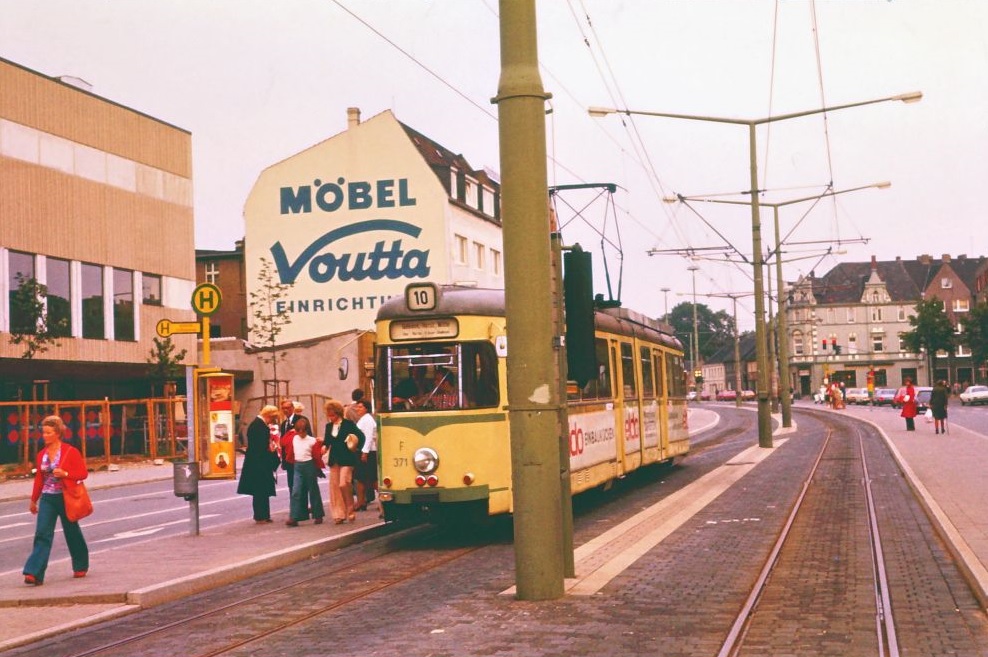
The
area often referred to as "the Ruhr" was concentrated between the River
Ruhr to the south and the River Emscher to the north. Outside this
central area, development was much more limited. To the south the land
became hilly, but smaller industrial communities developed and were
linked by an extensive network of inter-urban tramways often running
through very rural areas. By the 1970s, these lines had disappeared.
However, in the northern part of "the Ruhr" and close to the River
Emscher, the pattern of development was determined by the presence of
coal. Numerous small towns developed. The larger towns such as Bottrop,
Gladbeck, Herten and Recklinghausen had tram
links with the major cities, but also a network of their own which
included an east-west axis with numerous links to outlying
communities. The Vestische Strassenbahnen
had shrunk to a bare skeleton
by the early 1970s, but still linked to Essen's tramways at
Gelsenkirchen-Horst and to Bochum-Gelsenkirchen's at Horst and
Gelsenkirchen-Buer. A through service also ran from Recklinghausen to
central Bochum. North of the "main line" only the communities of Polsum
and Sinsen were attached to the network by this time. Tram
371, a standard Duwag six-axler, common to the Ruhr area and in the
Vestische fleet since 1957, runs through Herten
in what was a fine
modern alignment on Kaiserstrasse. Originally it had been hoped that the mooted regional
Stadtbahn would cover this route along the Emscher, but it proved to be
far too ambitious an aspiration.

Trams 382 and 371 on Kaiserstrasse, Herten. The
1970s saw the continuation of a long-established policy of route
closures. Herten was one of the last communities to remain connected.
The westward link to Gelsenkirchen-Buer closed on October 1st, 1980 and
the eastwards link to Recklinghausen on May 31st, 1981.

Buer
Rathaus was an important interchange on the tram system covering the
northern part of the Ruhr urban area. Having its own Rathaus betrayed
the fact that it was once an independent town, but it had been
incorporated into Gelsenkirchen along with many other communities. The
central area of Gelsenkirchen proper remained remote and far to the
south although reached by two differing tram routes. By the 1970s, the
Buer Rathaus
area was laid out pleasantly and still by the July 21st, 1977, when
Bochum tram 38 is seen, there remained a significant number of tramway
movements.

The
line from Gelsenkirchen to Buer (above) via Schalke had many
sections of upgraded track. Tram heads south on
De-La-Chevallerie-Strasse with Buer Rathaus on the right

Another view at Buer Rathaus, where lines approached from four directions,
featuring Bochum-Gelsenkirchen's tram 44. This tram is approaching Buer
Rathaus on De-La-Chevallerie-Strasse. In the distance the tracks fork
to give the option of two routes to Gelsenkirchen - left into Cranger
Strasse towards Erle or straight on on Kurt-Schumacher-Strasse to the
Schalke stadium

Stadtbahn-M car 324 from the Bochum-Gelsenkirchen fleet approaches the spaciously laid out platforms on Goldbergstrasse at Buer Rathaus on July 21st, 1977. With the later closure of the route to Recklinghausen, this became a stump terminus
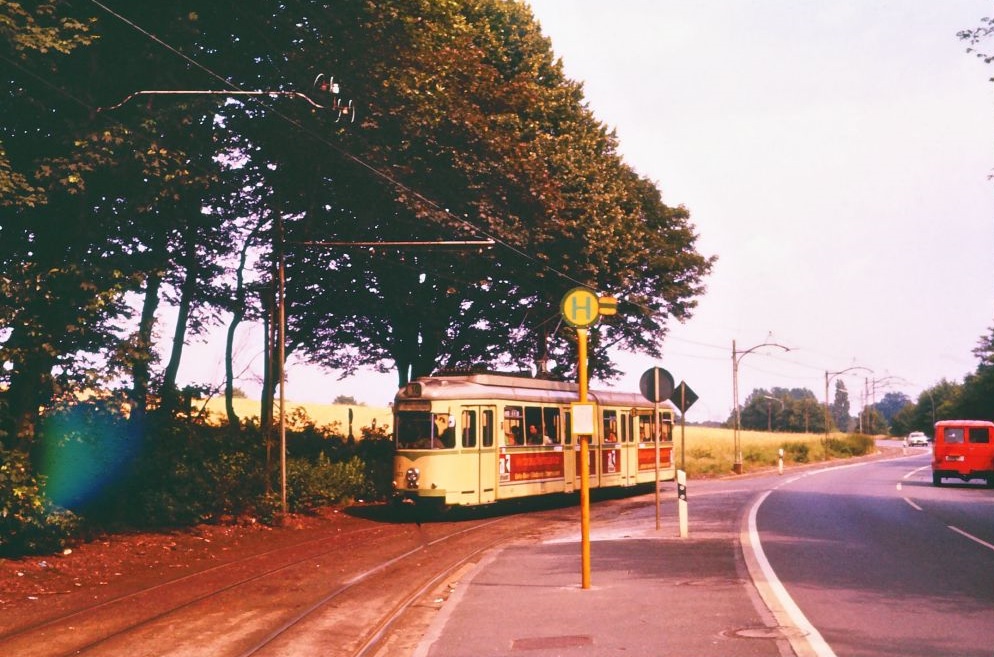
Tram
403 in the Vestische Strassenbahnen fleet was the last tram to arrive
as one of four bought from Monchengladbach in 1968 after the closure of
the latter system. It was originally put into service in 1960 and was
only slightly younger than the Vestische's own six-axled and of
similar design. 403 is seen not far from Buer
Rathaus en route from Recklinghasen via Herten. The rural nature of the
surroundings illustrates the fact that the Vestische lines linked
numerous smaller communities and that there really was not the realistic potential for a Stadtbahn here.

Latterly lying at the extreme eastern end of the remaining Vestische system, Recklinghausen was a substantial town in its own right. Tram 370 is seen on Konigswall

Recklinghausen Rathaus was served by trams from Herten until the link was severed in 1981

Another view in Recklinghausen
HERNE

Originally it had been anticupated that Recklinghausen, lying directly to the north of Bochum and linked by a tram line via Herne
which was operated jointly with the Bochum operation, would be
connected to the forthcoming Stadtbahn. Conversion of the tram line
appeared justified. It was not to be as The Vestische pulled out of the
joint service at the end of September 1982 and the authorities at
Recklinghausen had earlier withdrawn from participation in the
Stadtbahn project, primarily on cost grounds. Bochum continued with the
project, but the new standard gauge line built to Stadtbahn standards
and primarily in tunnel ended abruptly at Herne. Bochum tram 11
runs along a tram and pedestrian reservation on Bahnhofstrasse in
Herne. This section of line fell victim to the later opening of the
Stadtbahn line underneath.

Tram 298 runs along Schulstrasse in Herne on July 21st, 1977. This track was laid only to allow trams to run whilst the Stadtbahn was under construction
MULHEIM (Ruhr)
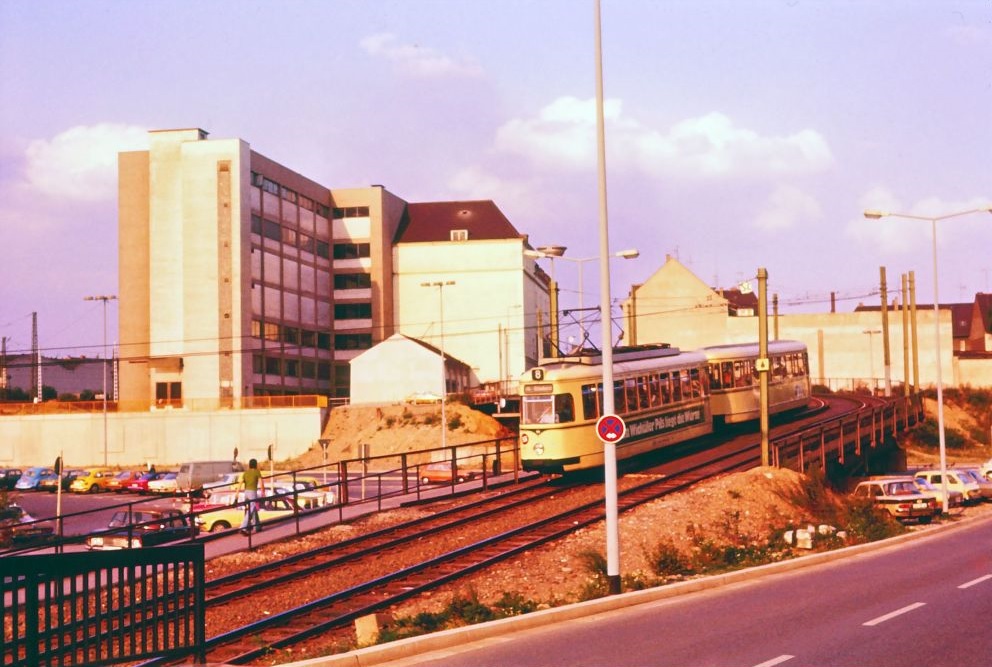
The town of Mulheim
lies immediately to the west of Essen in the densely populated Ruhr
region. It operates an extensive network of its own, but it was
possible to take trams to Essen (using two separate routes), Duisburg
to the west and, until its own system was closed in 1968, Oberhausen to
the north. The original Ruhr Stadtbahn proposals include each of these
links. In the photo above, Mulheim tram 226 and trailer 191 negotiate
temporary tracks aproaching Mulheim Hauptbahnhof on August 9th, 1976.
The line to Essen was under reconstruction with the first part of the
proposed Ruhr system already open as U18 between Essen and
Mulheim-Kirche. Tram route 8 continued until it was possible to extend
U18 to Mulheim Hauptbahnhof which was achieved on May 8th, 1977. Tram
226 was a four-axle "Grossraumwagen" built by Duwag in 1954 and the
trailer in 1955. The so-called "large capacity" cars were highly-modern
for their time, a considerable improvement on the outdated cars of the
late 1940s and a suitable bridge to the articulated cars which
dominated deliveries from the end of the 1950s.

A Grossraum tram and trailer are seen in central Mulheim on August 9th, 1976

In common with other local undertakings, Mulheim
ordered Stadtbahn-M cars for its local tram routes and also embarked on
tunnel-building to integrate these metre-gauge lines into a coordinated
network alongside the future standard-gauge Stadtbahn

Mulheim's
Stadtbahn M8 cars were painted in a tasteful yellow, whita and grey
livery rather than the red and white seen in Essen, Bochum and
Gelsenkirchen. 271 is at Kaiserplatz on August 9th, 1976

Tram and Stadtbahn construction works at Mulheim
Hauptbahnhof led to a range of temporary track alignments being used
for several years. Grossraum tram and trailer sets remained in
service. 227 and trailer 183 had, in the meantime, received
Mulheim's new corporate yellow livery.

The
repainting of trams to match the new Stadtbahn M8 cars in Mulheim was
still in progress. 256 was one of twelve six-axle articulated cars
received from Duwag between 1958 and 1964. They were an improvement
over the Grossraumwagen in that they had an even greater capacity, but
256 still needed a trailer, 191, which was of the older design. This
view was taken at Kaiserplatz on July 21st, 1977.

Although it remained possible to get directly to Essen and Duisburg by tram from central Mulheim,
only the line through Essen-Borbeck was jointly workable by both
local operators. As a consequence, Mulheim trams could be seen in Essen
and vice-versa. This was not the case with Duisburg because of a
track-gauge difference. Because of this, it was the Dusiburg transport
company which operated the service exclusively with their
standard-gauge trams. Only the final section of the route was on an
alignment shared with local Mulheim services and here four rails were
laid to accommodate each. In the above photo taken at
Mulheim-Stadtmitte on July 21st, 1977, Duisburg's tram 1065 waits to
depart for its home city using the outer set of rails. 1065 was
received from Duwag (as might be recognised from the distinctive Duwag
frontal styling) in 1966 as a six-axle tram but almost immediately
extended to eight-axle with an additional centre section. Duisburg
trams were still sporting the traditional German tram livery of cream
with a coloured band but were later to adopt orange and yellow before
choosing red. It had been anticipated that the tunneling under
Mulheim's city centre would result in a through service from Essen to
Duisburg, but this was not to happen and, in 2020, remains elusive with
an ever-reducing likelihood of it happening.
DUISBURG

Construction company hoardings in the background indicate that tunneling work is well under way in Duisburg on August 5th, 1976. Tram 1061 has just turned into Dusseldorfer Strasse from Konigstrasse

Konigstrasse in Duisburg
was itself a massive construction site in August 1976, Tram 1237 runs
eastwards alongside on temporary track with a service to neighbouring
Mulheim.

Duisburg
bought fourteen new eight-axle trams from Duwag in 1973. These were
traditionally styled and unlike those subsequently bought by Dortmund and Kassel which were
standard-gauge versions of the new trams which had arrived on
metre-gauge systems in the Ruhr area and designated "Stadtbahn-N".
1080 is seen looking east at Hauptbahnhof in the new orange and yellow livery on August 5th, 1976.

Looking west towards Konigstrasse at Duisburg Hauptbahnhof, also on August 5th, 1976
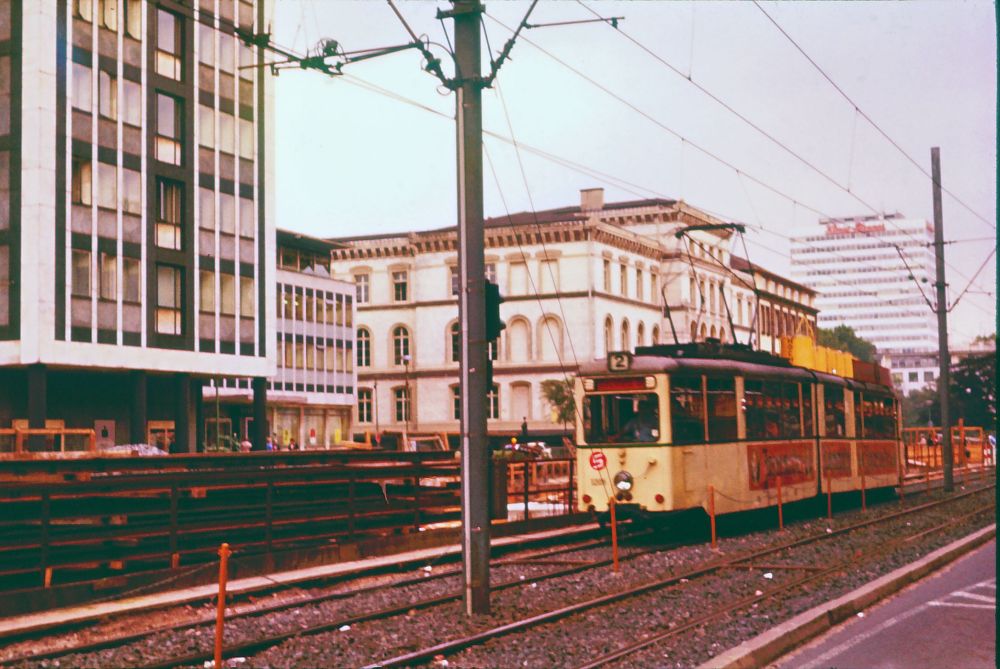
Despite
the new arrivals, old-fashioned trams were still in operation in
Duisburg on August 5th, 1976. 1205 is one of a number of
articulated cars created out of two older wartime trams in the late
1950s. Line 2 was a short run from Hochfeld to Kaiserberg on the
Mulheim route.

Duisburg
is linked with neighbouring Dusseldorf by a long interurban route in a
jointly operated service. Brand new trams delivered to the Dusseldorf
operators are seen at Sittardsberg. Sittardsberg station, built in 1970
was the first element of the new "Stadtbahn" to be opened in Duisburg.
It was, unusually, located in a cutting, but other parts of the line
were built on elevated track through the southern suburbs of the city.

Duisburg trams
also ran through Sittardsberg on the Dusseldorf route, whose conversion
to "Stadtbahn" standards had already been largely completed in the area
between the two cities' main built-up areas. Duisburg trams terminated
at a loop at Huckingen
DUSSELDORF

Dusseldorf
is the capital of Germany's North Rhine -Westphalia State which
encompassed the Ruhr area and as well as being the administrative
capital, Dusseldorf could lay a strong claim to be the commercial
capital of the whole of West Germany. Its street-based tramway was the
largest in the West. In the 1970s it made quick work of building the
tunnel underneath the city to bring U-Bahn services to Hauptbahnhof and
later beyond as part of the original Stadtbahn plan. The city's own
attempts at putting its own trams underground made slow progress
despite the early construction of the necessary tunnels around
Heinrich-Heine-Allee and it was another forty years before tram routes
running from the north-east of the city to the south were removed
from the surface. This last change saw the removal of what was for so
many years the central tram interchange : Jan-Wellem-Platz, seen in
1978, above with, what was then a modern GT8 tram and a more
traditional Duwag-styled tram and trailer.

A traditional scene outside the Wilhelm-Marx-Haus in central Dusseldorf in 1974

A modern GT8 tram in central Dusseldorf contrasts 1970s design with 1950s design. Four-axle Grossraumwagen motor and trailer set were still to de seen in 1978

Dusseldorf in 1975 : Heinrich-Heine-Allee is one big excavation site

Heinrich-Heine-Allee, Dusseldorf, in 1975

Heinrich-Heine-Allee, Dusseldorf,
in 1975. A new generation of trams (GT8) had just arrived but
Grossraumwagen trams and trailers were still plentiful. Trailer 1830
dates from 1955 and was produced in the city by Duwag whose production
was greatly helped by having such a large customer on its doorstep.

2266
is seen in front of the prominent Wilhelm-Marx-House office block on
Heinrich-Heine-Allee in 1975, with tunneling works not visible from
this angle. A large two-level station for a future U-Bahn interchange
would be built, but only one level brought into early use. Completed in
1924, the building was one of the earliest high-rise buildings in
Europe. Due to its close relationship with Duwag, the local Rheinische
Bahngesellschaft was an early adopted on the company's articulated
trams
KREFELD
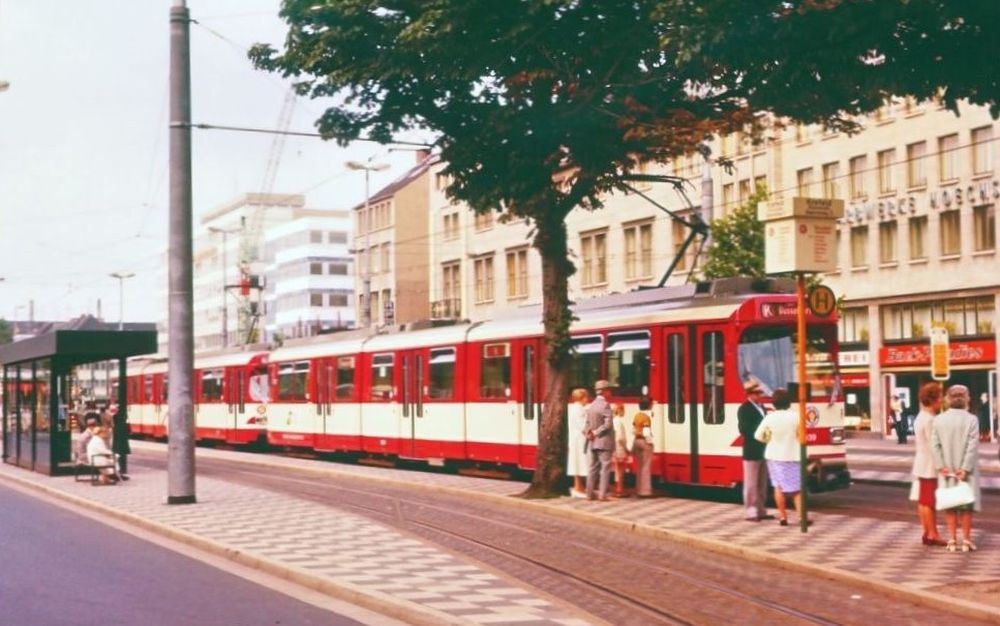
In addition to the fast line to Duisburg, Dusseldorf was connected to the town of Krefeld
by a similar long-distance route, designated as "K" (the Duisburg route
being "D" prior to the adoption of U-designated numbers). The K line
was standard-gauge which allowed it to run freely in Dusseldorf but a
separate alignment was needed in Krefeld where local trams ran on
metre-gauge. The terminus for the K line was Rheinstrasse where an
expansive tram stop was laid out accommodating both at separate
platforms. A K line train awaits departure on August 5th, 1976

With the two central tracks used by the K line vacated, Krefeld's
own trams occupy the outer platforms. 619 is visibly one of Duwag's
standard products. Duwag's main tram factory was in Dusseldorf (hence
Du - Wag) but the company also had facilities in Uerdingen, a suburb of
Krefeld, which concentrated on heavy railway vehicles. Duwag was the
leading supplier of trams throughout West Germany at this time. The
company became part of the Siemens organisation and the Dusseldorf
factory closed. Apart from the K line, Krefeld remained
relatively untouched by developments going on nearby. Expensive tunnels
were never an option nor a requirement and the tram network survived
relatively intact
WUPPPERTAL

One
tramway immediately to the south of the Ruhr area and originally
connected with other systems by a network of metre-gauge interurban
tramways in the Bergische Land was in Wuppertal. Created
by the merging of a number of towns in the Wupper valley, Barmen and
Elberfeld being the most significant, transport was heavily
concentrated in the valley alongside the river. This resulted in
services being provided by train, tram and latterly. bus .... but also
the Schwebebahn and elevated "hanging" railway of innovative design,
opened in 1901. In the above view taken on August 6th, 1976, tram 8013
picks up a decent number of passengers at Alter Markt tram stop inthe
Barmen area of the city. Immediately overhead is the Schwebebahn. The
Wuppertal tramway had already contracted considerably by 1976 and the
city authorities had decided that the duplication of service was
unacceptable, especially as the tramway had lost its branch lines over
the years. It was not until 1987 that the system was finally closed.
Tram 8013 was one of sixteen eight-axle Duwag cars rebuilt in 1958-60
out of former four-axle cars dating from 1954-55.
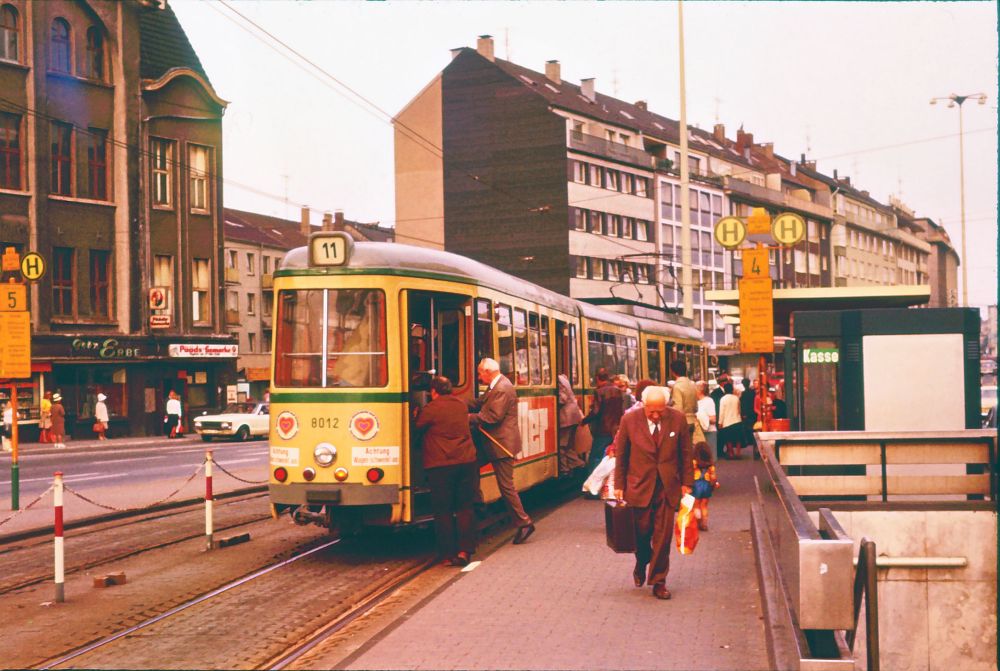
8012 at Alter Markt, Wuppertal on August 6th, 1976
MAINZ

The city of Mainz
became a Duwag customer for its modest-sized tramway in the 1960s, but
its chosen supplier had previously been Westwaggon. 227 was from their final
batch of deliveries to Mainz, arriving in 1961. It is seen at Hauptbahnhof
in 1976.

The first trams which Duwag delivered to Mainz were 228-235 in 1965. 229 is seen at Strassenbahnamt in 1976

228, the first of the Duwag cars for Mainz
is seen approaching Hauptbahnhof in 1976. The city transport company
was in the process of abandoning the ubiquitous cream for a more
striking orange livery. 228 had yet to be attended to.

Mainz
tram 240 featured the familiar Duwag look, but although it only arrived
in 1972, it was one of five originally built in 1960 and purchased
second hand from Heidelberg. It is seen in 1976 at Strassenbahnamt

Depots
are usually a good place to see the older members of a city's tram
fleet, either in store or in operation as shunters in the depot or
works cars for wider use around the network. Tram 93, built by the local Gastell
factory in 1929 was still around as the Mainz works car in 1976 .... and was later retained as part of Mainz's historical fleet

Unusual three-axle car 257 was one of three "Aufbauwagen" delivered to Mainz by
Westwaggon in 1949-50 having been reconstructed on the trucks of damaged wartime trams. By 1976
its working life was coming to a close but it still presented in fine
condition

A look inside the depot hall reveals that 260 and 259, two-axle Aufbauwagen received from Westwaggon in 1951 were still in Mainz alongside 93

It was not just old Aufbauwagen which were in storage in Mainz.
209, 210, 211 and 212 were neatly lined up along the wagon hall wall in
1976. These were in fact recent arrivals having been purchased from
Aachen, where the last tram line in operation closed at the end of
September 1974. Built in 1956 by Duwag, they had originally operated in
Monchengladbach but were moved to Aachen in 1969 following the closure
of tramway operations in the former. The new arrivals were already in
Mainz's orange and cream livery and hoping for an extended life on
their third tramway. It was not to be a long life, but 210 was later to
be preserved back in Aachen. Whatever the future for these
twenty-year-olds,
the future of tramway operations in Mainz was, like in many smaller
cities, a matter of intense debate amongst the public
and their representatives on the city council. The short branch
along industrial land alongside the River Rhine to Ingleheimer Aue
closed, but the rest of the system remained intact until there was a
change of political opinion in strong favour of trams.
DARMSTADT

Tram 025 at Schloss tram stop in central Darmstadt, outside the former castle of the Elector of the State of Hessen, in 1975

Darmstadt
tram 87 at Friedensplatz with the Weisser Turm (White Tower) in the
background. In 1975, two-axle cars were still in regular operation. 87
is one of four of the Verbandstyp design built by Rathgeber as late as
1956 at a time when Duwag were producing their much more advanced
Grossraumwagen. These cars were originally in service in Regensburg and
came to Darmstadt in 1964 after the closure of the tramway system in
the Bavarian city

Luisenplatz can be regarded as the centre of Darmstadt,
but although there are construction companies' information hoardings in
prominent view, the work is not involving tram tunnels, but a revamping
of the area to create a "new city". Six-axle tram 033 dates from
1962, but although built to closely resemble the standard Duwag design,
the manufacturer was actually DWM.

Tram 027 approaches Luisenplatz on Rheinstrasse

Tram 97 was the last of a batch of seven trams delivered by DWM in 1963/64

A remarkable survivor was 068 which was one of a number of trams dating from 1929 which was held in reserve in Darmstadt.
Line 9a was a special service in the western suburb of Grieheim
providing local runs as an extension of route 9 between the Grieheim depot
and Griesheim-Schule. It
ran from 1960 to 1976 using old double-ended stock because the terminus
did not have a loop so could not be used by the single-ended
articulated trams until construction was completed.

The
eastern terminus of line 9 was Ostbahnhof. Although 96 was one of
the city's newest trams at the time, the route from the city centre to
the eastern railway station was to fall victim to further cuts. It was
to be the last closure as Darmstadt, which, along with many other towns and cities, reversed its policy of managed decline to one of positive tramway expansion

Detail of tram 96 at Ostbahnhof

The loop at Ostbahnhof terminus in Darmstadt in 1975

Luisenplatz, Darmstadt,with
the Schloss in the background on July 23rd, 1977. Tram 95 is now in the
city's new livery which now includes a bright shade of orange

7602 with trailer 160 in Rheinstrasse, Darmstadt on July 23rd, 1977. This tram was one of eight of a new design supplied in 1976 by Waggon-Union. 160 is a Duwag product of 1965

The Darmstadt
tramway network integrates two former interurban light railways, one of
which is the line to Griesheim. Tram 92 is seen at Robert-Bosch-Strasse
on July 23rd, 1977.
WURZBURG

Tram 223 edges past traffic on Kaiserstrasse in Wurzburg
shortly before reaching Hauptbahnhof in 1975 . The tram was one of six
built by the Crede works in 1961-3 using the recovered trucks of older
trailers.

225 at Wurzburg
Hauptbahnhof showing the two-axle trucks and the suspended
centre-section which gave the city an acceptable articulated car at
modest expense
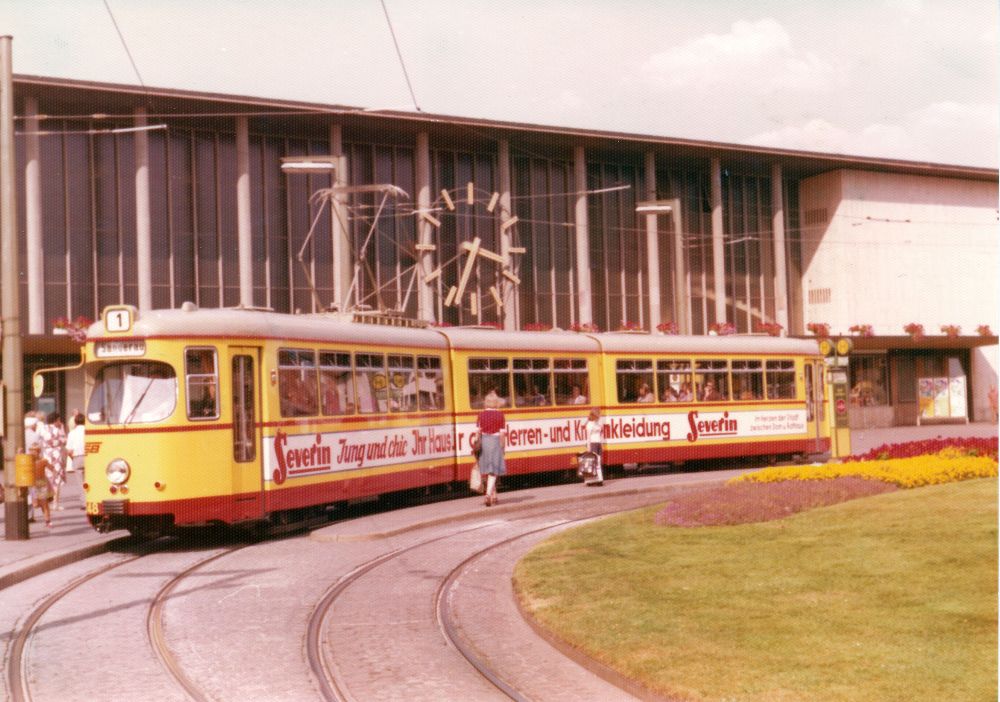
248 was a brand new delivery from Duwag in 1975 when seen at Wurzburg Hauptbahnhof
ULM

Ulm
in southern Germany was one of the smaller cities where the survival of
tram operations looked far from assured. Major closures in 1964 had
left the city with one remaining tram line which did receive some
modernisation. Rolling stock remained outdated although the ten
Grossraumwagen received from the south German manufacturer at Esslingen
in 1958 had a certain modernistic appearance even when seen in 1975. Tram 5
is seen at Bahnhofplatz

Fifteen two axle trailers built by Fuchs in 1953 were purchased by Ulm from Stuttgart in 1965.These certainly looked outdated in comparison with the Grossraumwagen in this view at Bahnhofplatz

A standard Ulm set turns into Bahnhofplatz from Olgastrasse on a working to Soflingen
AUGSBURG

Augsburg survived
the 1970s and embarked on a modernisation and expansion course, but in
1975 when this photo was taken on Fuggerstrasse at Konigsplatz with the
Stadttheater in the background, this was not at all clear. The Bavarian
city used the local MAN (Augsburg-Nurnberg Machine Factory) as its tram
supplier and in the 1970s these unusual five-axle trams dominated the
streets. 534 was supplied in 1964

Konigsplatz in Augsburg was and remains even more so, a busy central interchange for the city's extensive stree-based tramway

This view in Augsburg
is little changed although the trams have long since been replaced.
Burgermeister-Fischer-Strasse, with Moritzplatz in the background was
already traffic-calmed
FREIBURG

Freiburg-im-Breisgau
turned to the Esslingen factory in the 1960s when renewing its fleet in
the 1960s and 105, seen above passing through Schwabentor en route to
Littenweiler in 1977, was one of these

113 was one of a second batch which arrived in Freiburg
in 1966 and is seen eleven years later on Kaiser-Joseph-Strasse at
Bertoldsbrunnen. Freiburg was an early example of a city removing motor
vehicles from much of its historic city centre. In 1977, however, the future of the tramway was extremely
insecure and was much shrunken from its greatest extent.
Fortunately a change of direction was around the corner.

Bertoldsbrunnen, Freiburg in 1977

Freiburg's
attractive tram and pedestrian precinct is the scene for this 1976
view of a Verbandstyp tram of 1951 which had been converted to
offer a rolling pub attraction "for thirsty people" as was proclaned on
its front.

116
at Siegesdenkmal, about to enter the Kaiser-Joseph-Strasse precinct.
This tram was delivered by Rastatt to the Esslingen design in 1967

Freiburg, Bertoldstrasse at Stadttheater with one of the four eight-axlers obtained in 1971

Freiburg, Bertoldstrasse, viewed towards Bertoldsbrunnen. Tram 122, the final delivery of eight from Rastatt in 1968

Freiburg
204 at Oberlinden near Schwabentor. 204 was one of four eight-axle
double-articulated trams purchased from Duwag and delivered in 1971

Although tram 119 has long since gone, the scene remains the same at Oberlinden in
2020. The end of the 1970s saw a change of fortunes for trams in Freiburg
and the city embarked on a major expansion which is still continuing in
2020. A number of tram systems closed in the 1970s, but fewer than in
the 1960s. Those which made it through to 1980, in most cases,
experienced the same change in fortune that Freiburg enjoyed.
In
the 1970s, taking photos of trams was a matter of recording systems
before they closed - or so it seemed. In the 21st century, the
photographer has a full time job recording all the new systems being
established worldwide and the extensions to route mileage to those
already in operation. Quite some change.
Return to Homepage and Series
List













































































































































































